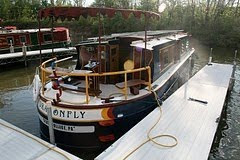 |
| A patient in the rehab center has a bizarre illness that makes him float TOO MUCH. Treatment includes attaching diver's weights to the shell so he can submerge |
The main work of the center is as a kind of turtle hospital, to care for sea turtles that are sick or injured. Most sea turtle populations can't really afford to lose a lot of individuals; six species are protected by the Endangered Species Act, three species are listed as critically endangered in the IUCN Red List, and all sea turtles are included in Appendix I of CITES.
It ain't easy being a turtle. They get tangled in fishing line. Crushed by dredges. They mistake floating plastic bags for jellyfish and die with a belly trashed by trash. People and all kinds of animals go after the eggs, which incubate on warm sand beaches. Electric lights in shoreline developments confuse baby turtles, who orient by moonlight to crawl from their nests down to the sea.
 |
| A large team of volunteers and interns helps the staff care for turtles. |
Some turtles looked healthy; they were brought to the center by people who found them found stunned and unable to move, in cold waters outside their usual winter range. The center would give them a home till spring.
Cap says, if he were a sea turtle, he would definitely feign cold shock. He could avoid all those ocean dangers and spend the winter in a hot tub, being hand-fed by cute girl volunteers.





No comments:
Post a Comment